What does DEX mean to you and your organization? There’s a lot to learn about the digital employee experience — we’re here to help.

.png)
Strategy is an important component of internal communications. Ensure you’re communicating through the right channels at the right frequency with our Internal Communications Channel Audit worksheet.
Access NowWith the rapid, incredibly dynamic digital transformation sweeping across every sphere of business globally, understanding the ins and outs of digital employee experience (DEX) is becoming a crucial factor. Employee experience (EX), specifically a DEX, impacts not just productivity, but also job satisfaction among employees. This, in turn, affects business outcomes including performance and productivity.
While it is still a relatively new concept, global research by international companies shows that its importance has skyrocketed in the past three years. This is primarily due to the shift towards remote and hybrid workplaces. But it’s getting more difficult to deliver a better digital experience. For example, one survey that polled more than 1,800 IT and business decision-makers bringing in annual revenue exceeding $250 million, found that 95% of leaders identified at least one major obstacle hindering their ability to deliver an excellent digital experience for end-users. It also found that 92% of respondents agreed that IT is “more responsible” for business innovation than it was three years ago.
The challenges are real and can be hugely demanding in many ways.
In this post, we are going to explore the concept of the digital employee experience and its various components. We aim to describe the role of digital transformation and show how it revolutionizes the employee experience as a whole. There will inevitably be challenges. So, we will look at what these might be and discuss what you can do to improve the DEX in your organization.
Importantly, we will focus on the most important steps needed to design an effective digital employee experience strategy. Then we will show you how to measure its success effectively. We will also touch on how to utilize digital platforms to enhance the overall experience.
Of course, employee experience statistics will always differ depending on many variables. But there are interesting similarities in these three research projects undertaken by international companies.
The Global Digital Employee Experience (DEX) Survey 2023 (mentioned above) was undertaken by digital solution company, Riverbed in May 2023. It found that 92% of IT and business decision-makers would be investing in DEX in the next five years. Slightly fewer (89%) were accelerating the adoption and implementation of digital experience. Furthermore, 95% said delivering a seamless DEX is important, and 56% said it was critically important.
Research company, Forrester states in Digital Workplace Trends to Watch Out For In 2023, that 60% of technology and business leaders indicated that improving employee experience (EX) during 2023 was a top IT priority for their organizations.
Digital software company, Applause, states in The 2023 Digital Employee Experience Trend Report that 86% of HR leaders agreed digital transformation was a strategic priority for their businesses. Their survey was smaller scale — only about 200 HR leaders across different industries — but, like Forrester, they found that 63% were prioritizing tech purchases to enhance the employee experience.
NTT Data’s 2023 Global Employee Experience Trends Report shows that 73% of organizations have invested in “mobility” because of hybrid or remote working needs in the past two years. Even more (75%) say they will continue to invest for the next two years.
But what does it all mean? And what exactly is a digital employee experience?
A digital employee experience, often abbreviated as DEX, refers to how employees interact, engage, and utilize digital tools in their workplace. It involves everything from the software and hardware they use to the platforms and systems available for communication, collaboration, and task completion. Creating a great DEX means providing systems and tools that are intuitive, easily accessible, and foster productivity and engagement among team members.
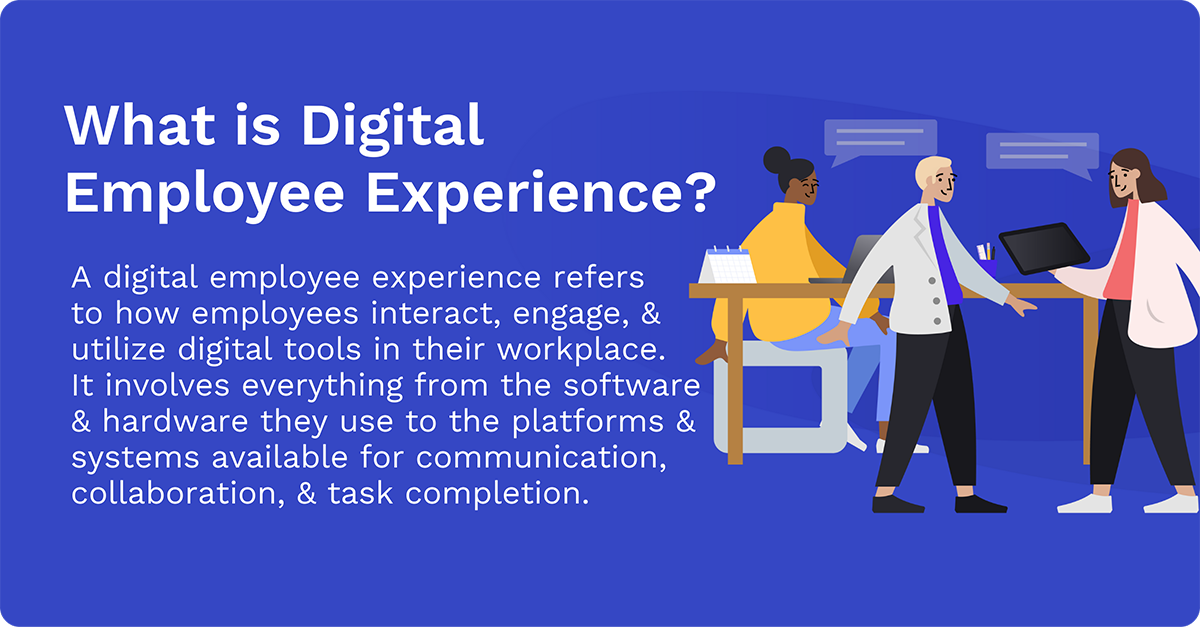
According to a Forbes article by technology writer, Leeron Hoory, most work-from-home workers use digital communication tools for up to 20 hours a week. Additionally, 45% of workers feel more connected to their team as a result of using digital communication. Furthermore, digital communication makes more than half (58%) of employees feel happy to be available more often.
A good digital employee experience not only makes daily work tasks easier but also contributes to employee satisfaction, morale, and overall engagement. But, as Hoory points out, 60% of employees experience increased burnout that results from communicating digitally. It’s even worse for remote workers, nearly 70% of whom reported burnout from digital communication.
We know that there are always downsides. But it is essential to realize that the digital employee experience plays a pivotal role in shaping a company's broader employee experience strategy. If employees find it hard to navigate a company's digital landscape, it may adversely affect their work experience, drive performance down, and generally create a negative workplace atmosphere.
It stands to reason that there is a difference between EX and DEX in general terms. While the concepts are related and often overlap, they are not entirely the same. The employee experience (EX) encompasses every interaction that an employee has with a company. These range from recruitment and onboarding to professional development and offboarding. It also includes both the physical and the digital work experience.
Conversely, the DEX is specifically concerned with an employee's interaction with the digital tools and platforms they use in their roles. Therefore, while EX might involve everything from office culture to internal communications, DEX only relates to the experience with digital tools and technology experience provided.
Designing a great digital employee experience involves various factors. Most DEX strategies involve, at the very least, the following components:
Adequate support and resources to help employees understand and effectively use these digital tools.
The right mix of these components can help ensure that employees have a smooth, productive digital experience, improving both their performance and job satisfaction.
Upgrade your company’s internal comms to enhance employee communication
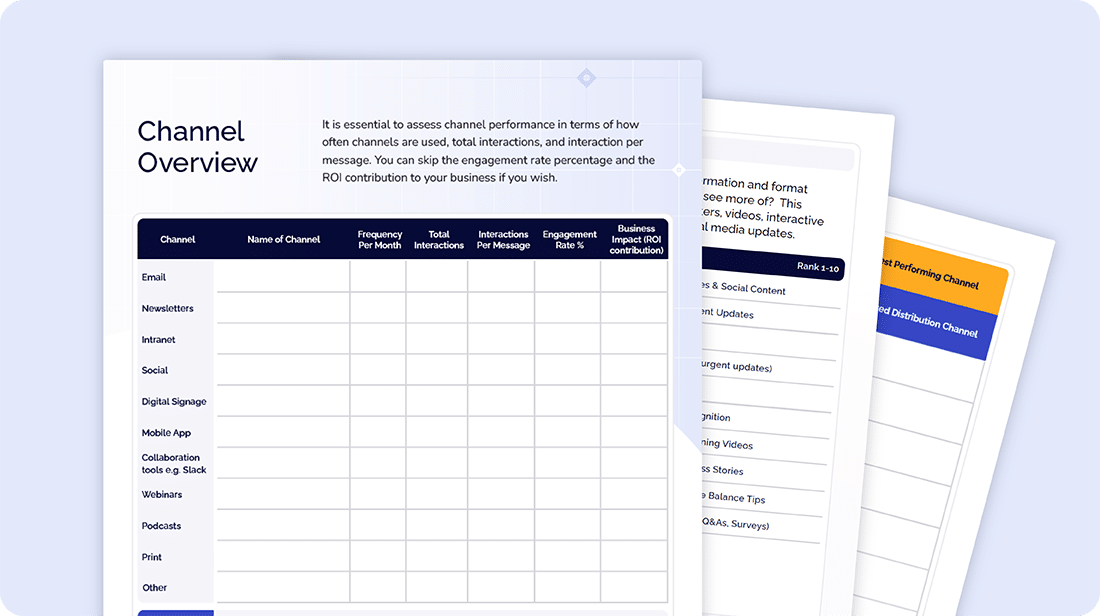
Digital transformation significantly influences the digital employee experience. As long ago as 2020, MIT CSIR revealed that research had shown senior leaders expected digital transformation efforts would significantly affect 67% of employees. These predictions are pretty accurate if you look at what recent research shows (see above).
But, as businesses increasingly adopt digital technology in their operational processes, the EX needs to evolve in tandem.
One major aspect of digital workplace transformation affecting DEX is the need for employees to acquire new skills. The influx of new technology necessitates training and development programs to bring employees up to speed. This transformation can also impact the way employees collaborate, with new digital platforms making remote work more viable and efficient.
Furthermore, digital transformation often involves the use of data analytics. This development can be leveraged to gain valuable insights into employee behavior and preferences, driving improvements in DEX. As a result, HR teams are increasingly relying on people analytics and HR data for this purpose.
It shows that embarking on digital transformation means not just implementing new technologies but also crafting really great DEX that accommodates these changes.
The transformation of employee experiences in the digital era is undeniably pivotal in defining a company's culture and work mode. Digital tools are increasingly shaping the work environment, influencing team dynamics, and enhancing the overall operational metrics. The innovation brought by digital transformation presents both opportunities and challenges for businesses, majorly impacting the digital employee experience.
The Riverbed global DEX survey found that nearly half of leaders consider a seamless digital experience as the key factor in keeping their workforce engaged. This surpasses traditional office perks such as weekly office happy hours or free coffee and snacks.
The pursuit of a great DEX dramatically enhances the concept of simply engaging employees. Companies that have embraced digital experiences help employees become more involved and enthusiastic about their duties, which goes a long way in improving the quality of their output. For instance, using digital tools to streamline teamwork and communication fosters a culture of collaboration, which often translates to improved productivity. The result is a motivated workforce, always ready and willing to deliver.
Apart from engagement, digitalizing employee experiences also has a significant impact on employee morale. When employees have access to efficient digital tools, it eases their tasks and reduces their stress levels at work. This enhances their overall morale and satisfaction, making their work experience enjoyable and fulfilling. Therefore, businesses striving for high levels of employee morale and satisfaction should not overlook the power of a good digital employee experience.
According to IE’s Digital Employee Experience (DEX) in the Enterprise: Progress, Patterns, and Gaps report based on a survey of 300 enterprises with 5000+ employees:
Despite the numerous benefits associated with a great digital employee experience, companies still face challenges in establishing effective digital workplaces. One of the main issues is the resistance to change, especially among employees who are accustomed to traditional methods of operations. The switch to digital tools may be seen as a threat, causing anxiety and reluctance among these team members.
A lack of a well-defined DEX strategy is another hurdle. Most businesses may not know where to start when it comes to enhancing their digital experience. The absence of a clear strategy is likely to lead to confusion, wastage of resources, and incoherent implementation of digital tools. An effective strategy should outline the company's objectives, set timelines, pinpoint responsibilities, and establish methods for evaluating progress.
Other challenges include limited resources and budget constraints, lack of technical support, and training issues. Despite these obstacles, the journey towards achieving a seamless digital employee experience is still achievable, with the right approach and commitment.
At the beginning of this guide, we mentioned that Riverbed’s Global Digital Employee Experience (DEX) Survey 2023 states that 95% of leaders Identify at least one major obstacle that hampers their ability to provide an excellent DEX. The top five obstacles they cite are:
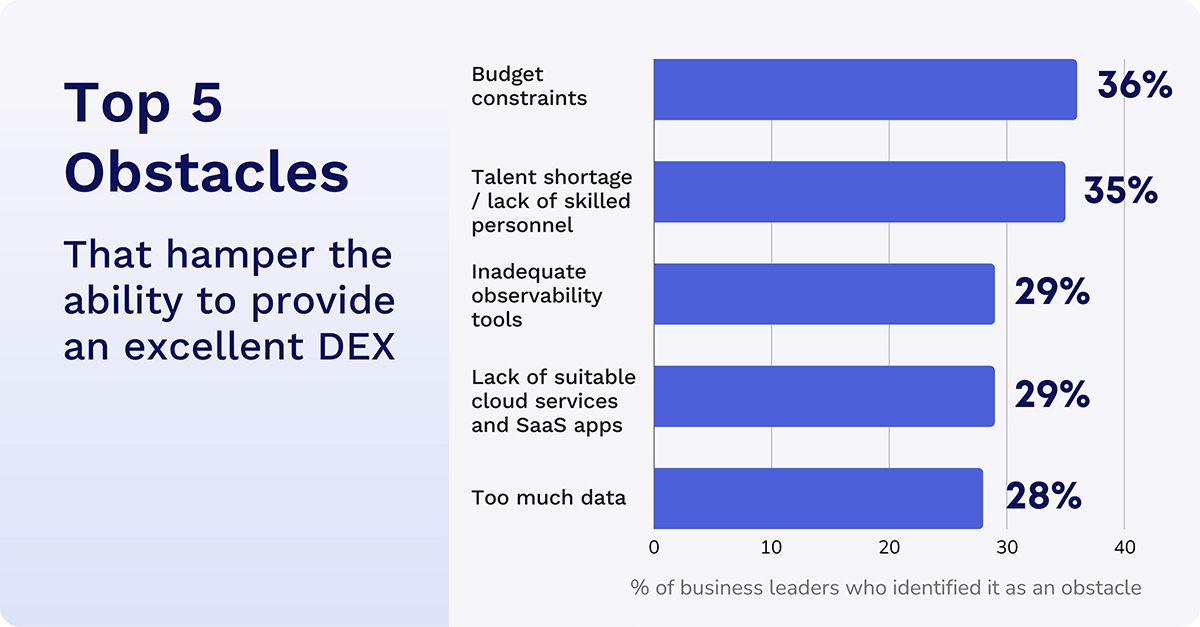
Needless to say, there are other concerns including security vulnerabilities (48%) and an ability to scale the IT organization (43%).
Proper planning and strategy are prerequisites to overcoming the barriers to an enhanced digital experience. Here are 10 steps that businesses can adopt to design a successful digital employee experience strategy.
Before you can map out a plan, understand your current digital state. Analyze your existing digital tools, how they're used, their effectiveness, and their impact on the work experience.
Engage your team throughout the entire process. Gather their thoughts, concerns, and suggestions regarding the current system and their vision for a great digital employee experience.
Outline what you want to achieve with your digital strategy. Align these objectives with your overall business goals.
Design the digital work environment you need based on the goals you have set. Make sure it caters to the needs and preferences of your employees and team leaders.
Since there are many digital tools available, take your time to choose the ones that best align with your business model, and employee needs, as well as those that support your objectives.
Plan for the changeover from the old to your new digital system. This plan should include training programs for employees and schedules for the deployment of new tools.
During and after the transition, ensure employees can readily access technical support to help them navigate issues and get accustomed to the new system.
Once the new digital environment is in place, continually monitor and evaluate its performance against the set objectives. This helps to identify any gaps or issues that might arise post-implementation and provide timely solutions.
Regularly collect feedback from team members on their user experience and make necessary adjustments for continuous improvement.
The digital landscape isn't static. Because of this it is vital to consistently update your strategy and innovate to match the changing digital trends. This will ensure that your digital experience is always up-to-date and relevant for your employees.
Crafting and implementing a DEX strategy, although challenging, presents an immense opportunity for a positive impact on both the workforce and the organization's overall output.
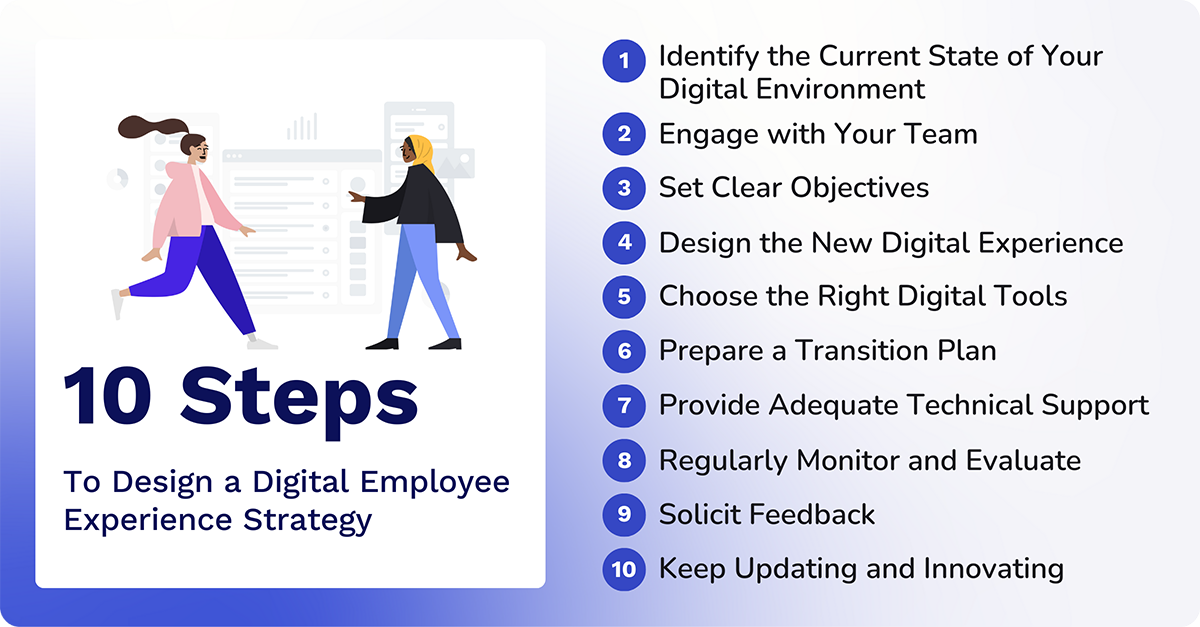
Measuring the digital employee experience may seem tough because of the multi-faceted aspects it covers. However, to get a comprehensive insight into the quality of digital employee experiences, you must take several crucial metrics into account.
Operational metrics are key to measuring the DEX in any organization. These can include user activity metrics, user satisfaction, and task completion rates. All of these offer a wealth of information about how employees interact with digital tools in the workplace.
People analytics is another vital tool for understanding an employee's digital experience. By analyzing HR data, user behavior, and patterns, you can better comprehend how digital transformation affects each team member’s work experience.
Employee feedback in the form of internal communications and surveys can complement the insights derived from operational metrics and people analytics. By gathering your team members' views on their technology experience, you can gain a deeper understanding of their satisfaction levels with the digital workplace tools they use daily.
Mastering the art of measuring digital employee experience will help HR teams and leadership identify the areas that need improvement. Ultimately, this will lead to a better DEX for everybody.
Upgrade your company’s internal comms to enhance employee communication

A DEX platform plays a significant role in creating an optimal digital employee experience. It's a digital hub where every aspect of an employee's lifecycle from onboarding to employee recognition, and even offboarding can be managed effectively.
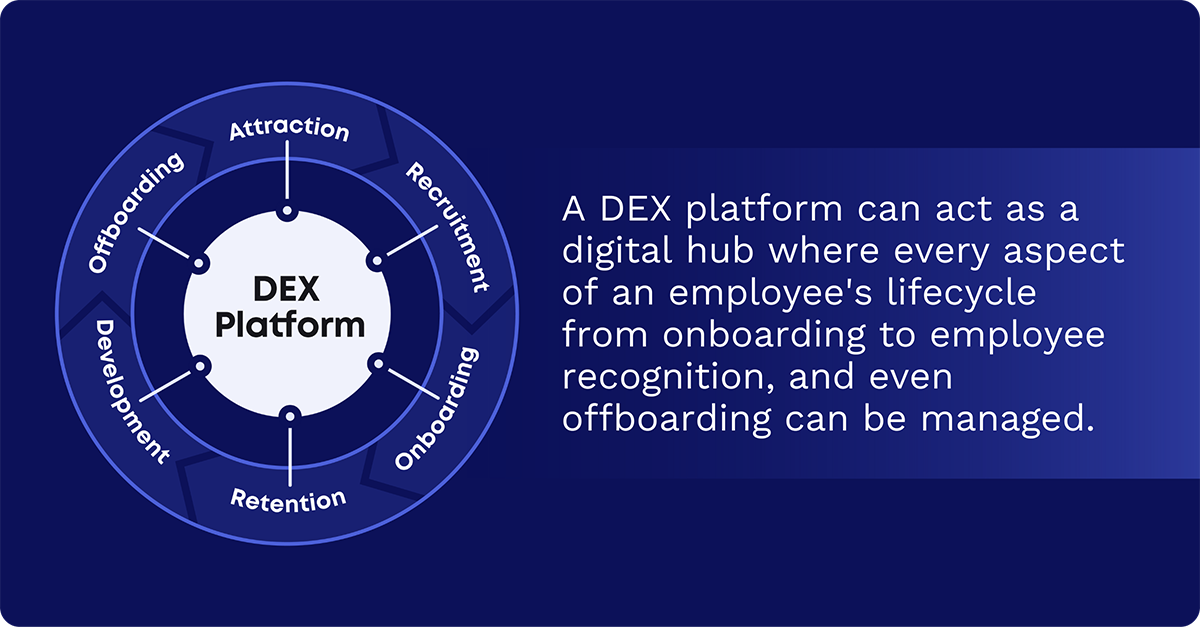
These platforms offer digital HR tools that can help create great digital employee experiences. They drive performance, and enable employees through operational efficiency and better internal communication, ultimately leading to positive employee morale and increased employee engagement.
The ideal platform will not only improve the user experience of your team but will also have direct positive impacts on your business results. However, remember that any DEX solution must be rolled out thoughtfully. The digital tools provided should align with the specific needs of your workforce, and adequate technical support must be available to mitigate any issues
Once you have harnessed and optimized your ideal DEX, you can achieve a better work environment, increased employee satisfaction, and enhanced productivity.
You can take positive steps to improve your DEX immediately using the Carkl Broadcast platform. Experience the power of our audience management platform, where personalized emails and intranet content come together to engage and inform your workforce. Join the ranks of millions of satisfied employees who rely on us to enhance their companies' communication, fostering improved employee satisfaction.
There’s a lot we can do to improve your internal communications strategy. But we suggest you start with an audit to see what needs to be done. Access our template free, right now.
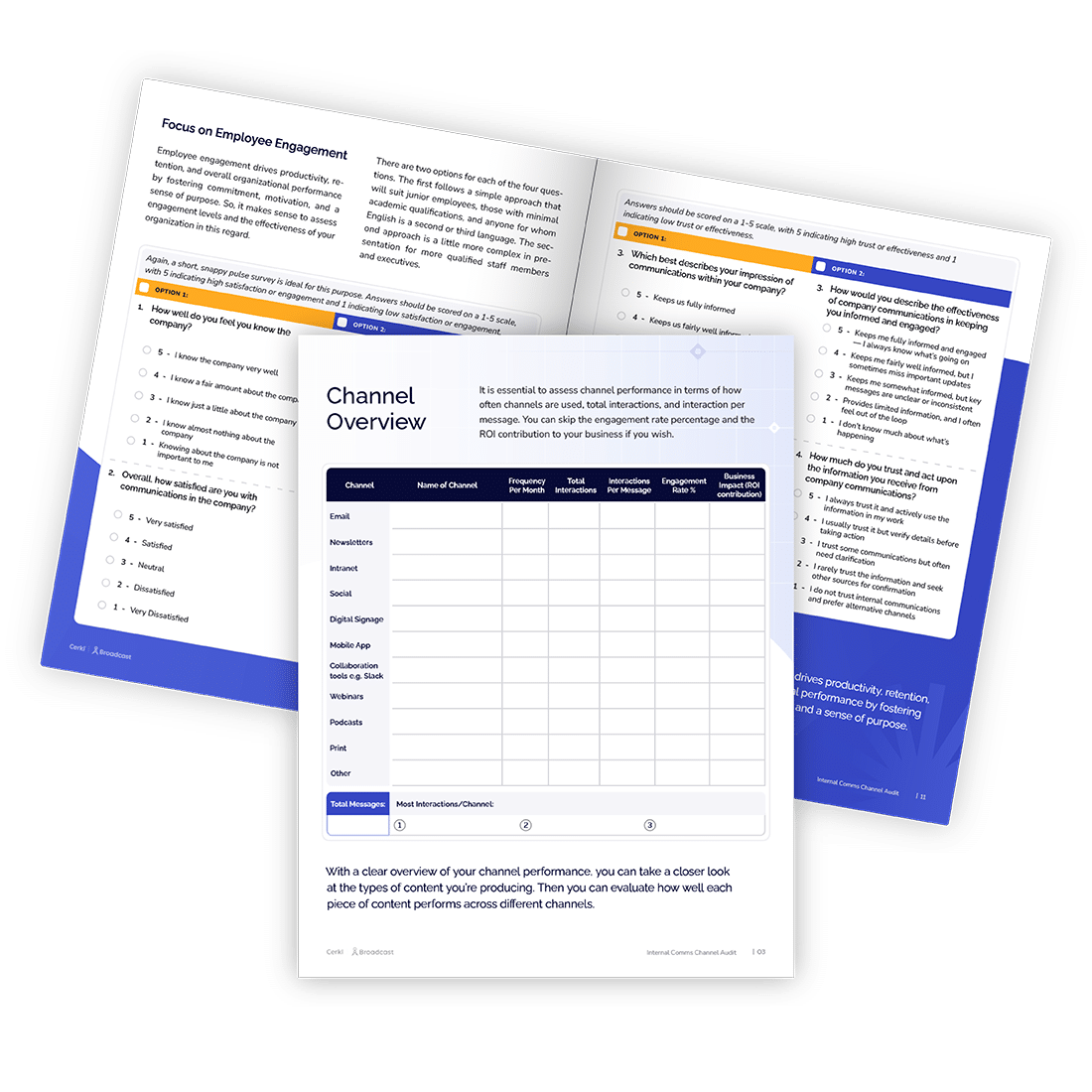
Upgrade your company’s internal comms to enhance employee communication
What is the digital employee experience? DEX refers to the overall interaction and satisfaction employees have with the digital tools, platforms, and technology provided by their organization to support their work.
What is the role of digital employee experience? The role of DEX is to enhance productivity, engagement, and well-being by ensuring seamless and user-friendly access to digital resources. It fosters effective communication and creates a positive technological work environment.
How do you create a digital employee experience? There are various ways to create a digital employee experience, though it’s best to combine them all for effect. Organizations can focus on user-centric design, provide training and support for digital tools, and gather feedback to make continuous improvements. They can also prioritize technologies that align with the needs and workflows of employees.
What are the components of DEX? Components of a DEX include user interfaces and experiences, collaboration tools, communication platforms, training programs, and digital policies. Ultimately, the overall integration of technology aims to streamline work processes and enhance employee satisfaction.

Upgrade your company’s internal comms to enhance employee communication